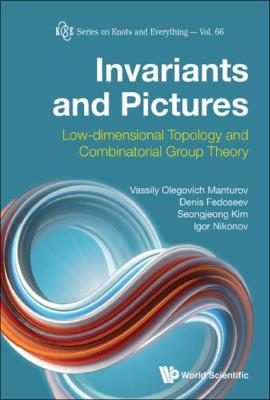ТОП просматриваемых книг сайта:
Invariants And Pictures: Low-dimensional Topology And Combinatorial Group Theory. Vassily Olegovich Manturov
Читать онлайн.Название Invariants And Pictures: Low-dimensional Topology And Combinatorial Group Theory
Год выпуска 0
isbn 9789811220135
Автор произведения Vassily Olegovich Manturov
Жанр Математика
Серия Series On Knots And Everything
Издательство Ingram
Invariants and Pictures
Low-dimensional Topology and Combinatorial Group Theory
Invariants and Pictures
Low-dimensional Topology and Combinatorial Group Theory
Vassily Olegovich Manturov
Bauman Moscow State Technical University, Russia and
Denis Fedoseev
Moscow State University, Russia
Seongjeong Kim
Bauman Moscow State Technical University, Russia & Moscow Institute of Physics and Technology, Russia
Igor Nikonov
Moscow State University, Russia
Published by
World Scientific Publishing Co. Pte. Ltd.
5 Toh Tuck Link, Singapore 596224
USA office: 27 Warren Street, Suite 401-402, Hackensack, NJ 07601
UK office: 57 Shelton Street, Covent Garden, London WC2H 9HE
Library of Congress Control Number: 2020012113
British Library Cataloguing-in-Publication Data
A catalogue record for this book is available from the British Library.
Series on Knots and Everything — Vol. 66
INVARIANTS AND PICTURES
Low-dimensional Topology and Combinatorial Group Theory
Copyright © 2020 by World Scientific Publishing Co. Pte. Ltd.
All rights reserved. This book, or parts thereof, may not be reproduced in any form or by any means, electronic or mechanical, including photocopying, recording or any information storage and retrieval system now known or to be invented, without written permission from the publisher.
For photocopying of material in this volume, please pay a copying fee through the Copyright Clearance Center, Inc., 222 Rosewood Drive, Danvers, MA 01923, USA. In this case permission to photocopy is not required from the publisher.
ISBN 978-981-122-011-1 (hardcover)
ISBN 978-981-122-012-8 (ebook for institutions)
ISBN 978-981-122-013-5 (ebook for individuals)
For any available supplementary material, please visit
https://www.worldscientific.com/worldscibooks/10.1142/11821#t=suppl
Printed in Singapore
Preface
A long time ago, when I first encountered knot tables and started unknotting knots “by hand”, I was quite excited with the fact that some knots may have more than one minimal representative. In other words, in order to make an object simpler, one should first make it more complicated. For example, see Fig. 0.1 [Kauffman and Lambropoulou, 2012]: this diagram represents the trivial knot, but in order to simplify it, one needs to perform an increasing Reidemeister move first.
Fig. 0.1Culprit knot
Being a first year undergraduate student (in Moscow State University), I first met free groups and their presentation. The power and beauty, and simplicity of these groups for me were their exponential growth and extremely easy solution to the word problem and conjugacy problem by means of a gradient descent algorithm in a word (in a cyclic word, respectively).
Also, I was excited with the Diamond lemma: a simple condition which guarantees the uniqueness of the minimal objects, and hence, solution to many problems (Chapter 1.4).
Being a last year undergraduate and teaching a knot theory course for the first time, I thought: “Why do not we have it (at least partially) in knot theory?”
Fig. 0.2The Diamond lemma
By that time I knew about the Diamond lemma and solvability of many problems like word problem in groups by gradient descent algorithm. The van Kampen lemma and Greendlinger’s theorem came to my knowledge much later.
I spent a lot of time working with virtual knot theory; my doctoral (habilitation) thesis [Manturov, 2007] was devoted to various problems in that theory: from algorithmic recognition of virtual knots to the construction of Khovanov homology for virtual knots with arbitrary coefficients.
Virtual knot theory (Chapter 3), which can be formally defined via Gauß diagrams which are not necessarily planar, is a theory about knots in thickened surfaces Sg × I considered up to addition/removal of nugatory handles. It contains classical knot theory as a proper part: classical knots can be thought of as knots in the thickened sphere. Hence, virtual knots have a lot of additional information coming from the topology of the ambient space (Sg).
By playing with formal Gauß diagrams, I decided to drop any arrow and sign information and called such objects free knots [Manturov, 2009].
It was an interesting puzzle for me in December 2008 in Heidelberg to construct invariants of free knots as I had never heard of any. What one should pay attention to is that all chords of a Gauß diagram of a virtual knots can be odd and even. Gauß himself knew that Gauß diagrams of planar curves and knots have no odd chords. Hence, odd chords can be the key point of non-triviality and non-classicality. When looking at Reidemeister moves, one can see that the chord taking part in a first Reidemeister move is even; two chords taking part in a second Reidemeister move are of the same parity, and the sum of parities of the three chords taking part in a third Reidemeister move is 0 modulo 2 if we count odd chords as 1 and even chords as 0 (Definition 5.8). Hence, odd chords can only cancel with “neighbouring” odd chords by the second Reidemeister moves; otherwise they persist.
In January 2009, I constructed a state-sum invariant of free knots valued in diagrams of free knots, i.e., framed four-valent graphs1 [Manturov, 2010]. For states, I was taking all possible smoothings at even crossings, imposing some diagrams to be zero. This invariant was constructed in such a way that all odd chords persisted and I got the formula
whenever K is a diagram of a free knot with all chords where no two chords can be cancelled by a second Reidemeister move (see Section 5.1).
The deep sense of this formula can be expressed as follows:
If a virtual diagram is complicated enough, then it realises itself.
Namely, K on the left hand side is some free knot diagram K, and K on the right hand side is a concrete graph. Hence, if K′ is another diagram of the same knot, we shall have [K′] = K meaning that K is obtained as a result of smoothing of K′. This

